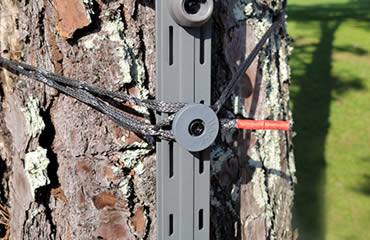Tree steps are the go-to system for running-and-gunning.
When installed and used properly, tree steps are a safe, highly portable and effective means of ascending a tree to set up and access lock-on style stands.
While a set of steps and a lock-on aren't any lighter to carry than a climbing stand, the ability to use them on almost any tree makes them a must-have for quick setups, especially on public land or when you're traveling to hunt.
One of the most common mistakes people make when purchasing tree steps is they don't initially buy enough. Steps are most commonly sold in sets of three, and while three steps can be enough to get you to a reasonable hunting height, you almost always need an additional step or two to go above the stand to allow for comfortable transitioning to the platform. Trust me on this one: Buy two sets. Four or five steps make for a much more comfortable setup.
If you already own tree steps, like me, you probably didn't buy two sets, and now you have steps from multiple manufacturers. The biggest issue with that is the different brands won't stack together well for carrying. That's fine if you can get to your stand site easily for setup. But for run-and-gun hunting, you'll want plenty of steps that all fit together and work the same.
The straps or ropes that hold your steps to the tree can be another source of annoyance. Each manufacturer uses a different system, but the general idea is the same. You start by attaching one end of a strap or rope to the step, wrap it around the tree and then attach it to the step again.
Contrary to what first-timers might think, tree steps don't lock super tight against the tree. Your body weight cinches the rope tight, but the step will shift from time to time. It's especially scary when you're reaching up to the next step to pull yourself up, and the bottom of the step you're pulling lifts away from the tree. Try to pull straight down when you're climbing.
That might sound unsafe, but if you use a lineman's rope while installing your setup, and you attach a life line above your stand, you will never have to worry about falling to the ground while using steps and a lock-on.
If you have easy access to your setup and intend to use it for an extended time, you can use a ratchet strap on each step. A ratchet strap cuts down on shifting but isn't really any safer. I like to use a ratchet strap on the top stick that goes above the stand because that stick is used more for a hand-hold and is prone to pull to the side as you move from the step to the stand.
Getting back to the ropes or straps used to attach the step to the tree, there are several reasons you might need to replace them. Whether you lose one or they start to show some wear, you can likely get replacements from the manufacturer.
Or, you can opt for Amsteel daisy chains. Amsteel is a super light and super strong rope that makes for an excellent strap replacement. You can make your own daisy chains, or you can buy them ready to go at about twice the price of buying the rope and doing it yourself. Many hunters are switching to Amsteel daisy chains even for brand new steps.
Most of the online tutorials for making daisy chains use 7/64-diameter Amsteel. I used 1/8-inch. It was only slightly more expensive, is stronger and not noticeably heavier or bulkier.
There are many tutorials on how to make your own daisy chains, but the one I used can be found here.
Read Recent Tip of the Week:• Looking Up: It's hard to stop a camera thief, but you don't have to make it easy.



.png)